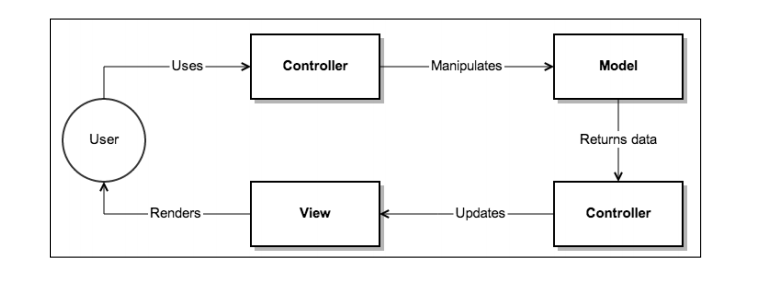一个app应用会随着需求,变得越来越庞大
MVC Model-View-Controller 模型可以更好的维护和修改
把一个应用分成三块
Model 数据和处理
View 视图
Controller 二者之间的联系

MVC模型在python web中的应用
web2py, Pyramid, Django (uses a flavor of MVC called MVP),
Giotto,
smart models
thin controllers
dumb views.
Model
Model是整个应用的基础, View 和 Controller 依赖于 Model
在Model中需要实现
。创建数据模型 和 相关的接口
。验证数据, 并且将错误返回给 controller
• Strive to perform the following for models:
Create data models and interface of work with them
Validate data and report all errors to the controller
• Avoid working directly with the user interface
View
视图从 Controller中获取处理后的数据, 然后展示
不应该包含复杂的逻辑, 逻辑处理应该在 Model 和 Controller 中完成
在View中需要实现
简化, 展示
• Strive to perform the following for views:
° Try to keep them simple; use only simple comparisons and loops
• Avoid doing the following in views:
° Accessing the database directly
° Using any logic other than loops and conditional statements (if-thenelse) because the separation of concerns requires all such complex
logic to be performed in models
Controller
从请求获取数据, 传递数据
• Strive to perform the following in controllers:
° Pass data from user requests to the model for processing, retrieving
and saving the data
° Pass data to views for rendering
° Handle all request errors and errors from models
• Avoid the following in controllers:
° Render data
° Work with the database and business logic directly
实例:
View
//views/main_page.html
<!DOCTYPE html>
<html lang="en">
<head>
<meta charset="UTF-8">
<title>Title</title>
</head>
<body>
<form action="/shorten/">
<label>
<input type="text" name="url" value="" />
Link to shorten
</label>
<input type="submit" value="OK"/>
</form>
</body>
</html>
//views/success.html
<!DOCTYPE html>
<html lang="en">
<head>
<meta charset="UTF-8">
<title>Title</title>
</head>
<body>
Congratulations! <br />
Your url:
</body>
</html>
Model
# models.py
# coding: utf-8
import pickle
class Url(object):
@classmethod
def shorten(cls, full_url):
"""Shortens full url."""
# Create an instance of Url class
instance = cls()
instance.full_url = full_url
instance.short_url = instance.__create_short_url()
Url.__save_url_mapping(instance)
return instance
@classmethod
def get_by_short_url(cls, short_url):
"""Returns Url instance, corresponding to short_url."""
url_mapping = Url.load_url_mapping()
return url_mapping.get(short_url)
def __create_short_url(self):
"""Creates short url, saves it and returns it."""
last_short_url = Url.__load_last_short_url()
short_url = self.__increment_string(last_short_url)
Url.__save_last_short_url(short_url)
return short_url
def __increment_string(self, string):
"""Increments string, that is:
a -> b
z -> aa
az -> ba
empty string -> a
"""
if string == '':
return 'a'
last_char = string[-1]
if last_char != 'z':
return string[:-1] + chr(ord(last_char) + 1)
return self.__increment_string(string[:-1]) + 'a'
@staticmethod
def __load_last_short_url():
try:
return pickle.load(open("last_short.p", "rb"))
except IOError:
return ''
@staticmethod
def __save_last_short_url(url):
pickle.dump(url, open("last_short.p", "wb"))
@staticmethod
def __load_url_mapping():
try:
return pickle.load(open("short_to_url.p", "rb"))
except IOError:
return {}
@staticmethod
def __save_url_mapping(instance):
short_to_url = Url.__load_url_mapping()
short_to_url[instance.short_url] = instance
pickle.dump(short_to_url, open("short_to_url.p", "wb"))
Contoller
# controller.py
# coding: utf-8
# Redirect function is used to forward user to full url if he came
# from shortened
# Request is used to encapsulate HTTP request. It will contain request
# methods, request arguments and other related information
from flask import redirect, render_template, request, Flask
from werkzeug.exceptions import BadRequest, NotFound
import models
# Initialize Flask application
app = Flask(__name__, template_folder='views')
@app.route("/")
def index():
return render_template('main_page.html')
@app.route("/shorten/")
def shorten():
# Validate user input
full_url = request.args.get('url')
if not full_url:
raise BadRequest()
# Model returns object with short_url property
url_model = models.Url.shorten(full_url)
# url_model.short_url
# Pass data to view and call its render method
short_url = request.host + '/' + url_model.short_url
return render_template('success.html', short_url=short_url)
@app.route('/<path:path>')
def redirect_to_full(path=''):
# Model returns object with full_url property
url_model = models.Url.get_by_short_url(path)
# Validate model return
if not url_model:
raise NotFound()
return redirect(url_model.full_url)
if __name__ == "__main__":
app.run(debug=True)
